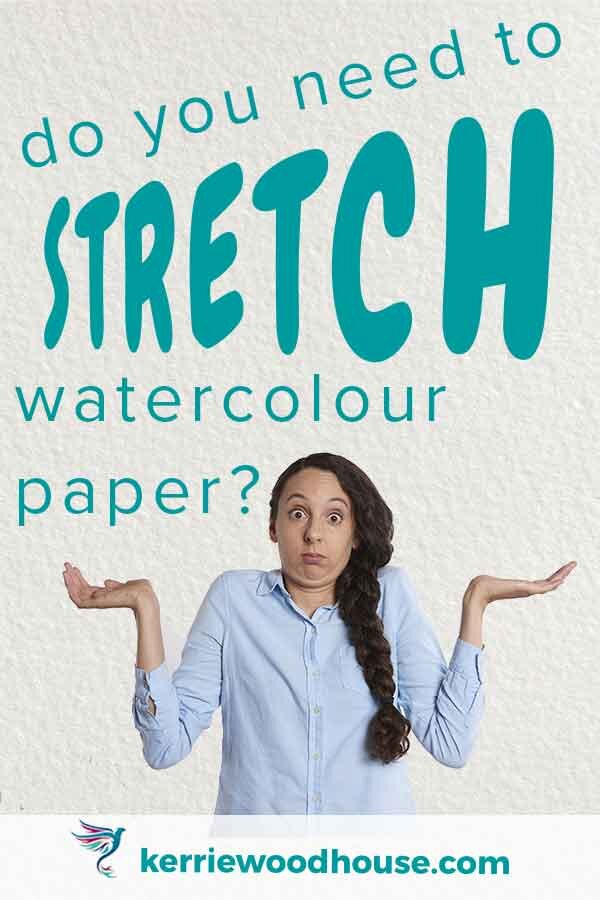Do You Need to Stretch Watercolour Paper?
Disclosure: This post may contain affiliate links. That means if you buy something we may possibly get a small commission at no extra cost to you.
One of the questions I often get asked is whether or not it is necessary to stretch your watercolour paper before painting.
There are a lot of ‘rules’ that you hear about watercolor painting and they are just the sort of thing that can intimidate the beginner and even completely discourage them from even attempting watercolor painting. Stretching the paper is definitely at the top of this list for me.
And in my opinion most of those rules should be ignored. (Definitely this one - more on that in a minute.)
Prefer to see a video version of this article? Here it is…
(The written version continues below the video)
What does it mean to ‘stretch’ watercolour paper?
Some painters maintain that before you paint you must completely saturate the paper, preferably by completely immersing it in a tub of water.
Then they instruct you to attach this soaking paper to a firm support, something like a board. Some recommend gummed tape, some staples but the idea is to firmly affix the wet paper to the board on all sides.
The next step is to leave it to dry completely. Once dry you can remove it from the board and commence painting.
Why do people recommend stretching watercolour paper?
The whole point of this exercise is to avoid ending up with a buckled painting.
Since lots of water is likely to be used, the paper expands during painting as it swells with the moisture. This can happen unevenly leaving a warped page - no longer entirely flat (apparently). Pre stretching the paper is supposed to swell the paper evenly and then shrink it evenly as it dries so that the it won’t buckle when you start painting.
Is it necessary to stretch watercolour paper?
Good heavens, no. At least, not in my opinion!
In fact I strongly recommend against it.
I think that if you have to go through that right palaver before you paint, you put yourself under way too much pressure. Having invested so much time and effort in the paper you are now most likely to be terrified of ‘ruining’ it.
For me, part of the appeal of watercolour painting is that it is a low maintenance medium. Easy set up, easy clean up, minimal supplies needed. Unless of course you decide you need to stretch the paper!
I paint to relax - I certainly don’t need a tedious chore to endure before I begin!
This practicality aside, I have never experienced any of the extreme warping that is discussed. However, I always recommend a minimum of 300gsm paper, preferably 100% cotton.
With this weight of paper and my style of painting I have never found the paper too buckled after painting. I use a lot of water!
Can you stretch watercolour paper without wetting it?
Yes, it is possible to stretch the watercolour paper across a board without wetting it. The best way to do it is to tape the paper to a board all the way around.
There are two reasons for doing this - neither of which has anything to do with buckled paintings, in my mind!
Firstly, I am sometimes in the mood for a lot splashy washes with splatter and drips… say for a sky, perhaps? It is easiest to do this when you have taped your paper to a board so that you can tip the board to make the paint run.
Secondly, taping the paper to the board is the easiest way to ensure a clean border around the painting. One of the most satisfying things to watch is the peeling off of the tape to reveal the crisp white edge when the painting is done! Don’t know why… it just is. Have a look below and see what I mean.
I recommend 2 types of tape for this purpose.
Painter’s or artists tape
This looks like masking tape but is low tack so it should (in theory) remove easily from the paper without damaging the painting.
Always remove the tape by pulling away from the painting rather than in towards the painting just to be cautious.
Packing tape
The kind of wide packing tape that you would use to seal those big boxes you need when you move house is surprisingly effective.
I had to see it with my own eyes to believe it. It really does remove cleanly without damaging the paper.
Any other alternatives to stretching the watercolour paper?
As I said, the whole paper stretching issue can be avoided if you use 140lb/300gsm paper or heavier.
If you do want to use a lower weight of paper than 300gsm/140lb, then I do have one more suggestion. I don’t recommend it, since the type of paper you paint on significantly impacts your whole painting experience.
However, lighter paper is a bit cheaper. I have succumbed to the charms of such paper myself and bought Fabriano 200gsm paper in the past. The only way I am prepared to use this weight of paper though, is if it comes in a block rather than a pad.
Pads are gummed only on one of the 4 sides, but blocks are gummed on all sides. This effectively stretches the paper for you.
Paint on the top sheet of the block and let the finished painting dry completely before removing it. There will be a little notch - one small space usually about an inch wide that is not gummed. You slip a letter opener or palette knife into the notch and then slide it around the edge of the painting to slice it off the block.
Can you stretch watercolour paper after painting?
Perhaps you might find yourself with a finished painting that is a bit buckled. So is it too late to stretch the paper after painting?
To stretch it, yes, it is too late, but there are a few things that you can try which may help flatten a buckled painting.
If you are going to frame a painting it will be pressed under glass and that flattens it out a bit too. If not - poor quality paper in my opinion!
(Just to be clear - when I say pressed under glass I really mean that it will be pressed under the mount, since the glass should not rest directly on the surface of the framed painting.)
There are a few other things that you can try if you find your finished painting is buckled. I have never had the experience of an intolerably warped painting myself, so please bear in mind that this conventional wisdom rather than something I have tested myself!
Some artists recommend turning the finished painting over and painting the whole of the back with clear water. You can use a sponge or a brush, but you would want to take care that no water gets round the sides and spoils the finished painting with a watermark.
Other artists suggest painting a big cross with water on the reverse of the painting is enough to level it up. Either way, leave the painting to dry completely and your lumps and bumps should hopefully even up. (In the painting, you understand…😉this probably won’t help for lumps and bumps elsewhere.)
Placing a totally dry painting under a heavy book for the night should also flatten it.
I have even heard of some people ironing the reverse of the painting with a cool iron!
As I say I have NEVER had to do any of these things, and I have boxes and boxes of paintings - all flat enough for me.
You will find watercolour purists who insist that stretching the paper is essential but in my experience, modern paper from a reputable brand (Arches, Fabriano, Saunders and Waterford, Bockingford, Hahnemuhle -just examples there will be plenty more and availability may vary depending on geographic location) in a minimum of 300gsm weight simply doesn’t need it.
Painting on decent watercolour paper is a treat.
In my opinion it is the most important of the supplies you need for watercolour. The paper you use can make or break your painting experience.
If you want to know more about the supplies you need for watercolour painting, I have a free class that covers everything you need to know.
Click the button below and enrol yourself today.
Are you on your own painting journey?
One of these might be useful…








